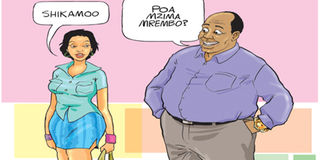What’s wrong with shikamoo?

There is something peculiar about the greeting, exclusive to Swahili culture.
What you need to know:
Shikamoo is a greeting for those older than us. Surprisingly, when greeted this way, some people just utter a simple ‘Poa.’
There is something unique about the way we greet our elders, starts Rachel Magege. There is something peculiar about the greeting, exclusive to the Swahili culture. Rachel, 24, recently returned to Tanzania from the US where she was pursuing her Bachelor’s Degree in Law. When she arrived in the US, she immediately noticed the difference.
“I remember feeling awkward that a child could say ‘Hi Rachel’ like it was normal. And you can greet your Professor with a simple Hello. But when you get used to him, you greet him with his first name. ‘Hi James’. There is no way I could do that here,” she says and adds: “That is why I appreciate our way of greeting. I think it is a way of showing respect.”
That awkward moment
Not everyone wants to be respected this way, says James Martin, 31, a businessman based in Arusha. “I hate Shikamoo,” he says of the greeting, especially if it is a young woman involved.
“I prefer to be asked how I am doing. Shikamoo creates so much boundaries. It makes me feel like they are showing me so much respect. It becomes hard for me, or men in general, to make any other advances. The relationship becomes too formal.”
Robby Salehe, 33, a management accountant based in Dar es Salaam, knows this too well. In fact, most young women must have encountered this situation.
In her view, there must be a reason why her shikamoo gets an abruptly spoken ‘poa’. Poa is usually a response to mambo, a greeting among peers.
“If it is a woman, perhaps they think I am too old to say shikamoo. I am big in size, so that confuses many. But if it is a man, it is possible that they want something else from me,” she says.
What is this shikamoo about?
Swahili Professor, Abdulaziz Y. Lodhi, a Professor Emeritus at Uppsala University in Sweden explains that shikamuu is derived from nashika miguu yako, (I touch your feet). This is an ancient Bantu greeting used to address respectfully all elders and people in position.
In all civilisations people develop new greetings from time to time influenced by economic and social developments, political changes and integration with immigrants.
Our Kiswahili civilisation has a continuous history of almost 2,000 years developed by the coastal people coming in close contact with people from various parts of the Indian Ocean.
The professor explains that in different Bantu tribal cultures, it was normal practice to kneel in front of the Chief, or even lie down and touch his feet as if he were a king as kings were divine and representatives of God on earth. Such practices have gradually disappeared with the abolition of divine kingship and feudalism in many societies.
The response, marhaba, which meant ‘You have my blessings’ is of course derived from Arabic. Prof Lodhi believes this Arabic loan replaced a longer original Bantu response during the 8th century when Islam was firmly established along the EA coast and Arabic became the literary language of the people all around the rim of the Indian Ocean.
Prof Lodhi recalls how he and Mwalimu Nyerere (Tanzania’s first president) used to greet each other and how that changed with time. Back in the 60s and early 70s, he always greeted Mwalimu Nyerere with a shikamoo mwalimu, and Nyerere would respond with a simple marhaba!
“But later in the mid-70s when I was Chairman of TANU-ASP in Scandinavia, Mwl Nyerere responded with marhaba maalim! And later from 1994 when we travelled together to Swaziland he started responding with a marhaba profesa! or marhaba bwana profesa!
“Only once in Stockholm in the home of Balozi Wilson Tibaijuka, an old colleague from Dar es Salaam from the 60s, did he greet me shikamoo Profesa before I could greet him first. I had to respond with marhaba mwalimu. Then he added with a hearty laughter ‘Nimekuwahi leo! Nawe upate fursa ya kunipa marhaba.’ (I greet you first today so that you can also say marhaba to me.) Mwl. Nyerere and I had serious literary and political relations and at the same time a joking relationship.”
Is it another form of oppression?
In her blog, Nasaha.net, Ashura Kayupayupa analyses an unpublished essay, ‘What’s wrong with Shikamoo’ (1995) authored by Rakesh Rajani who is currently Head of Civic Engagement and Governance with Ford Foundation. The paper reflects on the effects this greeting has in the process of learning and public engagement.
“Rakesh explained that since the salutation was brought by Arab Sultans to undermine Tanzanian elders and creating inferiority complex, it was not an appropriate salutation for people with equal relationship, rather for the one who is a master and the other one who is a slave. He challenges this greeting among adults today,” writes Ashura.
Ashura highlights Rakesh’s views, saying that this is also true for the teacher-pupil relationship whereby the student surrenders their right to equal participation in learning by saying shikamoo to the teacher.
Rakesh dares us to imagine a day when a teacher will encourage students to question, challenging them to think outside the box without holding a stick. That is his problem with shikamoo.
Changing times
Amina Juma, 42, a librarian based in Dar es Salaam says she remembers how wives used to greet their husbands shikamoo in her tribe of Wanyamwezi from Tabora.
“When I was a young girl, there were many homes where the man was much older than his wife. The wife would comfortably greet her husband this way. I know it might sound strange today, but why not? It was considered a respectful greeting. However, I don’t think that women today would greet their husbands this way,” she says with a laugh.
Robby, the management accountant says that this generation does not like shikamoo at all. It is quite normal for a teenager to say ‘Hi’ to a 10-year senior than themselves.
It is partly the fault of the ones receiving this greeting, says James, the Arusha-based businessman. He is also of the view that most young people think that they are too cool for shikamoo.
He blames it on ‘utandawazi’ (globalisation). Many would say ‘unanizeesha’ which translates to ‘you are making me look older than I really am.’
Prof Lodhi explains that his younger colleagues, and sometimes even those who are his age, greet him with a shikamoo profesa! However recently one of the Kiswahili Professors in Dar greeted him with ‘mambo profesa?’ Instead of responding with a poa, Prof Lodhi said mambo bambam! Which the younger professor had never heard before! “People think mambo is a new greeting developed by the young generation – No! It was there already in the 40s and we boys of my generation were using it. In my experience, most people in the world have no historical depth. Most of them are acculturated, in fast growing unplanned urban areas living in a cultural vacuum.”
Its cultural significance
Modern African cities are a good example of large uprooted populations that are developing vibrant new Western-influenced cultures, which are exploited by new technologies and related commercialism necessitating new terminologies and language usage, says Prof Lodhi.
Prof Lodhi further explains that in East Africa, we have a special linguistic situation where Kiswahili, the only native language with a long literary tradition in the whole of east-central Africa, which is a minority language as far as the number of native speakers are concerned, is the most widely spread language with a very high status, always competing with English.
It has been ‘nationalised’ and it is the 2nd or 3rd language speakers of Kiswahili, who are the vast majority and who have been changing it especially by mixing it with their own ethnic tongues, marginalising the traditional native 1st language speakers of Kiswahili.
“I think that this point has to be made clear before one can answer your question “Do we really need shikamoo anymore?” For a Mswahili like me, the question cannot arise since it is part of our deep-rooted basic culture and social mannerism expressing good upbringing and showing respect to elders! What is wrong with it? On the contrary we need it even more today when an increasing number of children are growing up with little or no respect for elders.”
“I would suggest one should go and present this question to those to whom Kiswahili belongs as their legitimate cultural heritage. The ‘cultural significance’ of shikamoo – marhaba and many such socio-cultural elements depends on who is using them and in which contexts.”
The professor goes on to say that; “ the question raised, I believe involves an insignificant minority of people in East Africa and who I am inclined to claim are not traditional native speakers of Kiswahili.
One cannot ‘prescribe’ which greetings people should use and which not; however, one can do a good job ‘describing’ how certain greetings are used by a specific group/category of persons, in what contexts and why, and what are their socio-cultural and linguistic backgrounds. Only then one can claim it is a scientific study.”
Email: [email protected]




